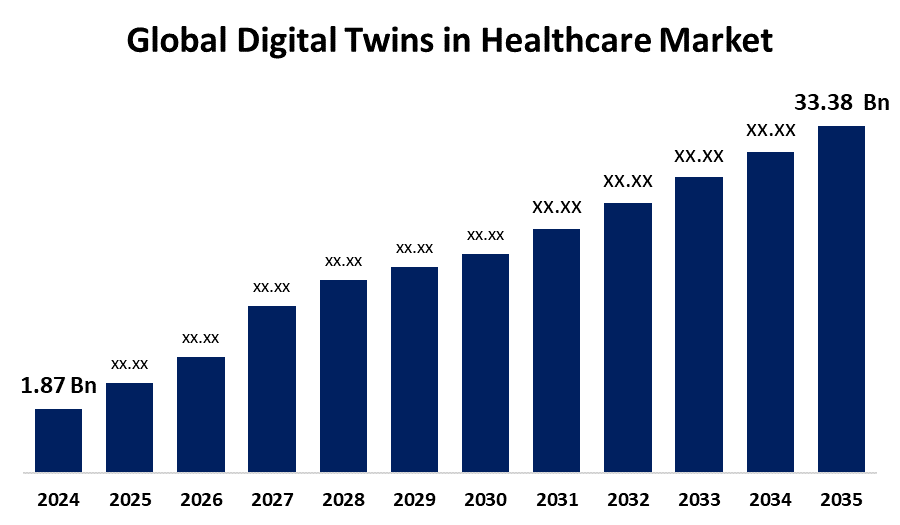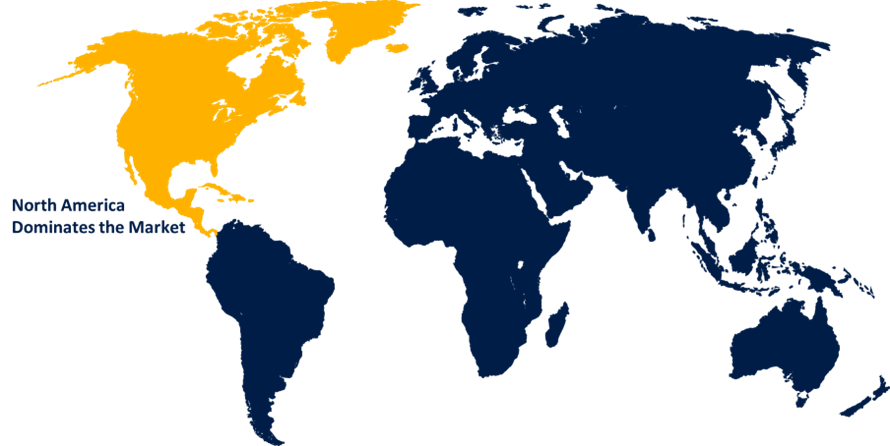Global Digital Twins in Healthcare Market Size, Share, and COVID-19 Impact Analysis, By Application (Personalized Medicine, Drug Discovery, Medical Education, and Workflow Optimization), By End User (Providers, Research & Academia, and Payers), and By Region (North America, Europe, Asia-Pacific, Latin America, Middle East, and Africa), Analysis and Forecast 2025 - 2035
Industry: HealthcareGlobal Digital Twins in Healthcare Market Insights Forecasts to 2035
- The Global Digital Twins in Healthcare Market Size Was Estimated at USD 1.87 Billion in 2024
- The Market Size is Expected to Grow at a CAGR of around 29.95% from 2025 to 2035
- The Worldwide Digital Twins in Healthcare Market Size is Expected to Reach USD 33.38 Billion by 2035
- Asia Pacific is Expected to Grow the fastest during the forecast period.

Get more details on this report -
The global digital twins in healthcare market size was worth around USD 1.87 billion in 2024 and is predicted to grow to around USD 33.38 billion by 2035 with a compound annual growth rate (CAGR) of 29.95% from 2025 and 2035. The growing significance of digital twins in emerging economies and the increased focus on sophisticated real-time data analytics indicate profitable business opportunities.
Market Overview
The term "digital twins in healthcare" refers to a computerized representation of an actual healthcare system, process, or institution. Artificial intelligence (AI), data analytics, and Internet of Things (IoT) sensors are used to create a dynamic, real-time model that mimics patient conditions, medical equipment, or healthcare facilities. Healthcare professionals can use this technology to estimate demand, streamline procedures, and simulate treatments in order to increase efficiency, personalized medicine, and predictive diagnostics.
Personalized medicine and customized treatment regimens can be developed by using digital twins to simulate organs, specific cells, or a person's genetic profile, physiological characteristics, and lifestyle choices. For instance, in September 2023, Dassault Systèmes (US) launched the "Emma" avatar for their digital twin technology in an effort to increase public awareness of health studies.
The rise in this industry may be ascribed to a variety of factors, including the growing number of digital twin businesses serving healthcare applications and the expanding government initiatives towards digital health. The growing desire for customized medication, improvements in data analytics and simulation capabilities, and the growing adoption of digital health technologies are driving the expansion of the digital twins in healthcare market.
Report Coverage
This research report categorizes the digital twins in healthcare market based on various segments and regions, forecasts revenue growth, and analyzes trends in each submarket. The report analyses the key growth drivers, opportunities, and challenges influencing the digital twins in healthcare market. Recent market developments and competitive strategies such as expansion, type launch, development, partnership, merger, and acquisition have been included to draw the competitive landscape in the market. The report strategically identifies and profiles the key market players and analyses their core competencies in each sub-segment of the digital twins in healthcare market.
Global Digital Twins in Healthcare Market Report Coverage
| Report Coverage | Details |
|---|---|
| Base Year: | 2024 |
| Market Size in 2024: | USD 1.87 Billion |
| Forecast Period: | 2024-2035 |
| Forecast Period CAGR 2024-2035 : | 29.95% |
| 2035 Value Projection: | USD 33.38 Billion |
| Historical Data for: | 2020-2023 |
| No. of Pages: | 180 |
| Tables, Charts & Figures: | 130 |
| Segments covered: | By Application, By End User, By Region and COVID-19 Impact Analysis. |
| Companies covered:: | IBM, Microsoft Corporation, Sim and Cure, Koninklijke Philips N.V., Dassault Systèmes, PrediSurge, GE Healthcare, Amazon Web Services, Inc., Unlearn.ai, Inc., ThoughtWire, Virtonomy GmbH, Oracle Corporation, Siemens Healthineers AG, NVIDIA Corporation, and Others. |
| Pitfalls & Challenges: | COVID-19 Empact, Challenge, Future, Growth, & Analysis |
Get more details on this report -
Driving Factors
Increased expenditures from both public and private organizations, the growing use of digital twins, and technical developments are some of the factors anticipated to propel digital twins in healthcare market. The digital twins in healthcare market have expanded as a result of the rise in popularity of Industry 4.0 technologies, which enable smooth data integration and the creation of virtual representations of real assets, procedures, and even the human body.
The use of digital twins in the healthcare industry is growing quickly due to its many advantages, which include better resource use, better patient outcomes, and improved medical research. The rise in digital twins in healthcare is driven by developments in AI, IoT, and big data analytics, as well as by the growing need for individualized treatment, better predictive diagnoses, and more effective hospital administration.
Restraining Factors
High installation costs, intricate integration with current systems, data security difficulties, regulatory compliance problems, and a lack of technological know-how prohibit the broad deployment and scaling of digital twins in the healthcare market.
Market Segmentation
The digital twins in the healthcare market share is classified into application and end user.
- The personalized medicine segment dominated the market in 2024 and is projected to grow at a substantial CAGR during the forecast period.
Based on the application, the digital twins in the healthcare market is divided into personalized medicine, drug discovery, medical education, and workflow optimization. Among these, the personalized medicine segment dominated the market in 2024 and is projected to grow at a substantial CAGR during the forecast period. The potential of personalized medicine to increase treatment efficacy, improve patient outcomes, and lessen side effects is driving its expansion.
- The providers segment accounted for the largest share in 2024 and is anticipated to grow at a significant CAGR during the forecast period.
Based on the end user, the digital twins in the healthcare market is divided into providers, research & academia, and payers. Among these, the providers segment accounted for the largest share in 2024 and is anticipated to grow at a significant CAGR during the forecast period. Factors include improved hospital diagnostic capabilities, enabling more accurate illness diagnosis, according to the healthcare providers section.
Regional Segment Analysis of the Digital Twins in Healthcare Market
- North America (U.S., Canada, Mexico)
- Europe (Germany, France, U.K., Italy, Spain, Rest of Europe)
- Asia-Pacific (China, Japan, India, Rest of APAC)
- South America (Brazil and the Rest of South America)
- The Middle East and Africa (UAE, South Africa, Rest of MEA)
North America is anticipated to hold the largest share of the digital twins in the healthcare market over the predicted timeframe.

Get more details on this report -
North America is anticipated to hold the largest share of the digital twins in the healthcare market over the predicted timeframe. Growing government financing and the growth of healthcare organizations that specialize in this technology are the main drivers of the North America region. The use of digital twins in US healthcare has increased due to significant expenditures in research and development, opening up profitable potential. The need for digital twin solutions is increased by the region's status as an innovation hub and the presence of significant players such as IBM, Microsoft, Ansys, Twin Health, Unlearn.AI, and Verto.
Asia Pacific is expected to grow at a rapid CAGR in the digital twins in the healthcare market during the forecast period. The market for healthcare digital twins is expected to rise as a result of increased investments in AI-based technologies made by private investors, venture capitalists, and non-profit organizations. Furthermore, it is projected that the growing use of IoT devices in the area would fuel market demand throughout the course of the projection year. Market expansion is being bolstered by the increasing use of both organic and inorganic tactics.
Europe is predicted to hold a significant share of the digital twins in the healthcare market throughout the estimated period. The focus on digital transformation, healthcare innovation, and government backing has made the Europe area strong. The European Virtual Human Twins Initiative, for example, is a framework established by the European Union that makes it easier to create and use cutting-edge virtual human twin solutions in the fields of healthcare and wellbeing.
Competitive Analysis:
The report offers the appropriate analysis of the key organizations/companies involved within the digital twins in the healthcare market, along with a comparative evaluation primarily based on their type of offering, business overviews, geographic presence, enterprise strategies, segment market share, and SWOT analysis. The report also provides an elaborative analysis focusing on the current news and developments of the companies, which includes type development, innovations, joint ventures, partnerships, mergers & acquisitions, strategic alliances, and others. This allows for the evaluation of the overall competition within the market.
List of Key Companies
- IBM
- Microsoft Corporation
- Sim and Cure
- Koninklijke Philips N.V.
- Dassault Systèmes
- PrediSurge
- GE Healthcare
- Amazon Web Services, Inc.
- Unlearn.ai, Inc.
- ThoughtWire
- Virtonomy GmbH
- Oracle Corporation
- Siemens Healthineers AG
- NVIDIA Corporation
- Others
Key Target Audience
- Market Players
- Investors
- End-users
- Government Authorities
- Consulting And Research Firm
- Venture capitalists
- Value-Added Resellers (VARs)
Recent Development
- In April 2023, Oracle (USA) and Deloitte (UK) worked together. This partnership aims to create a patient-centered, future-ready healthcare delivery system by upgrading electronic health records, streamlining processes, and utilizing AI-driven insights. They want to address the changing demands of the healthcare sector and boost operational effectiveness by fusing Oracle's technology portfolio with Deloitte's industry experience.
- In October 2023, Siemens Healthineers AG (Germany) and CEA (France) collaborated together on research to increase the industrial use of digital twins. In the fields of autonomous driving, intelligent robots, and health, the project would investigate the use of digital twin technologies.
Market Segment
This study forecasts revenue at global, regional, and country levels from 2020 to 2035. Spherical Insights has segmented the digital twins in the healthcare market based on the below-mentioned segments:
Global Digital Twins in Healthcare Market, By Application
- Personalized Medicine
- Drug Discovery
- Medical Education
- Workflow Optimization
Global Digital Twins in Healthcare Market, By End User
- Providers
- Research & Academia
- Payers
Global Digital Twins in Healthcare Market, By Regional Analysis
- North America
- US
- Canada
- Mexico
- Europe
- Germany
- UK
- France
- Italy
- Spain
- Russia
- Rest of Europe
- Asia Pacific
- China
- Japan
- India
- South Korea
- Australia
- Rest of Asia Pacific
- South America
- Brazil
- Argentina
- Rest of South America
- Middle East & Africa
- UAE
- Saudi Arabia
- Qatar
- South Africa
- Rest of the Middle East & Africa
Frequently Asked Questions (FAQ)
-
1. What is the CAGR of the digital twins in the healthcare market over the forecast period?The global digital twins in the healthcare market is projected to expand at a CAGR of 29.95% during the forecast period.
-
2. What is the market size of the digital twins in the healthcare market?The global digital twins in the healthcare market size is expected to grow from USD 1.87 Billion in 2024 to USD 33.38 Billion by 2035, at a CAGR of 29.95% during the forecast period 2025-2035.
-
3. Which region holds the largest share of the digital twins in the healthcare market?North America is anticipated to hold the largest share of the digital twins in the healthcare market over the predicted timeframe.
Need help to buy this report?